What do the kidneys do?
The kidneys are bean-shaped organs, each about the size of a fist. They are located near the middle of the back, just below the rib cage, one on each side of the spine.
A sophisticated reprocessing machines.
Every day, a person’s kidneys process about 200 quarts of blood to sift out about 2 quarts of waste products and extra water. The wastes and extra water become urine, which flows to the bladder through tubes called ureters. The bladder stores urine until releasing it through urination.
Wastes in the blood come from the normal breakdown of active tissues, such as muscles, and from food. The body uses food for energy and self-repairs. After the body has taken what it needs from food, wastes are sent to the blood. If the kidneys did not remove them, these wastes would build up in the blood and damage the body.
The actual removal of wastes occurs in tiny units inside the kidneys called nephrons. Each kidney has about a million nephrons. In the nephron, a glomerulus—which is a tiny blood vessel, or capillary—intertwines with a tiny urine-collecting tube called a tubule. The glomerulus acts as a filtering unit, or sieve, and keeps normal proteins and cells in the bloodstream, allowing extra fluid and wastes to pass through. A complicated chemical exchange takes place, as waste materials and water leave the blood and enter the urinary system.
At first, the tubules receive a combination of waste materials and chemicals the body can still use. The kidneys measure out chemicals like sodium, phosphorus, and potassium and release them back to the blood to return to the body. In this way, the kidneys regulate the body’s level of these substances. The right balance is necessary for life.
In addition to removing wastes, the kidneys release three important hormones:
- erythropoietin, or EPO, which stimulates the bone marrow to make red blood cells
- renin, which regulates blood pressure
- calcitriol, the active form of vitamin D, which helps maintain calcium for bones and for normal chemical balance in the body
What is renal function?
The word “renal” refers to the kidneys.
The terms “renal function” and “kidney function” mean the same thing.
Health professionals use the term “renal function” to talk about how efficiently the kidneys filter blood.
People with two healthy kidneys have 100 percent of their kidney function.
Some people are born with only one kidney but can still lead normal, healthy lives.
People with reduced kidney function often get kidney disease and will get worse.
Serious health problems occur when people have less than 25 percent of their kidney function.
When kidney function drops below 10 to 15 percent, a person needs some form of renal replacement therapy—either blood-cleansing treatments called dialysis or a kidney transplant—to sustain life.
Why do kidneys fail?
Most kidney diseases attack the nephrons, causing them to lose their filtering capacity. Damage to the nephrons can happen quickly, often as the result of injury or poisoning. But most kidney diseases destroy the nephrons slowly and silently. Only after years or even decades will the damage become apparent. Most kidney diseases attack both kidneys simultaneously.
The two most common causes of kidney disease are diabetes and high blood pressure. People with a family history of any kind of kidney problem are also at risk for kidney disease.
Diabetic Kidney Disease
Diabetes is a disease that keeps the body from using glucose, a form of sugar, as it should. If glucose stays in the blood instead of breaking down, it can act like a poison. Damage to the nephrons from unused glucose in the blood is called diabetic kidney disease. Keeping blood glucose levels down can delay or prevent diabetic kidney disease. Use of medications called angiotensin-converting enzyme (ACE) inhibitors or angiotensin receptor blockers (ARBs) to treat high blood pressure can also slow or delay the progression of diabetic kidney disease.
High Blood Pressure
High blood pressure can damage the small blood vessels in the kidneys. The damaged vessels cannot filter wastes from the blood as they are supposed to.
A doctor may prescribe blood pressure medication. ACE inhibitors and ARBs have been found to protect the kidneys even more than other medicines that lower blood pressure to similar levels. The National Heart, Lung, and Blood Institute (NHLBI), one of the National Institutes of Health, recommends that people with diabetes or reduced kidney function keep their blood pressure below 130/80.
Glomerular Diseases
Several types of kidney disease are grouped together under this category, including autoimmune diseases, infection-related diseases, and sclerotic diseases.
As the name indicates, glomerular diseases attack the tiny blood vessels, or glomeruli, within the kidney. The most common primary glomerular diseases include membranous nephropathy, IgA nephropathy, and focal segmental glomerulosclerosis.
The first sign of a glomerular disease is often proteinuria, which is too much protein in the urine. Another common sign is hematuria, which is blood in the urine. Some people may have both proteinuria and hematuria. Glomerular diseases can slowly destroy kidney function. Blood pressure control is important with any kidney disease. Glomerular diseases are usually diagnosed with a biopsy—a procedure that involves taking a piece of kidney tissue for examination with a microscope. Treatments for glomerular diseases may include immunosuppressive drugs or steroids to reduce inflammation and proteinuria, depending on the specific disease.
Inherited and Congenital Kidney Diseases
Some kidney diseases result from hereditary factors.
Polycystic kidney disease (PKD), for example, is a genetic disorder in which many cysts grow in the kidneys. PKD cysts can slowly replace much of the mass of the kidneys, reducing kidney function and leading to kidney failure.
If a child has a kidney disease, the child’s doctor should find it during a regular checkup. The first sign of a kidney problem may be high blood pressure; a low number of red blood cells, called anemia; proteinuria; or hematuria. If the doctor finds any of these problems, further tests may be necessary, including additional blood and urine tests or radiology studies. In some cases, the doctor may need to perform a biopsy.
Some hereditary kidney diseases may not be detected until adulthood. The most common form of PKD was once called “adult PKD” because the symptoms of high blood pressure and renal failure usually do not occur until patients are in their twenties or thirties. But with advances in diagnostic imaging technology, doctors have found cysts in children and adolescents before any symptoms appear.
Other Causes of Kidney Disease
Poisons and trauma, such as a direct and forceful blow to the kidneys, can lead to kidney disease.
Some over-the-counter medicines can be poisonous to the kidneys if taken regularly over a long period of time. Anyone who takes painkillers regularly should check with a doctor to make sure the kidneys are not at risk.
How do kidneys fail?
Many factors that influence the speed of kidney failure are not completely understood. Researchers are still studying how protein in the diet and cholesterol levels in the blood affect kidney function.
Acute Kidney Injury
Some kidney problems happen quickly, such as when an accident injures the kidneys. Losing a lot of blood can cause sudden kidney failure. Some drugs or poisons can make the kidneys stop working.
These sudden drops in kidney function are called acute kidney injury (AKI). Some doctors may also refer to this condition as acute renal failure (ARF).
AKI may lead to permanent loss of kidney function. But if the kidneys are not seriously damaged, acute kidney disease may be reversed.
Chronic Kidney Disease
Most kidney problems, however, happen slowly. A person may have “silent” kidney disease for years. Gradual loss of kidney function is called chronic kidney disease (CKD) or chronic renal insufficiency. People with CKD may go on to develop permanent kidney failure. They also have a high risk of death from a stroke or heart attack.
End-stage Renal Disease
Total or nearly total and permanent kidney failure is called end-stage renal disease (ESRD). People with ESRD must undergo dialysis or transplantation to stay alive.
What happens if the kidneys fail completely?
Total or nearly total and permanent kidney failure is called ESRD.
If a person’s kidneys stop working completely, the body fills with extra water and waste products. This condition is called uremia. Hands or feet may swell. A person will feel tired and weak because the body needs clean blood to function properly.
Untreated uremia may lead to seizures or coma and will ultimately result in death. A person whose kidneys stop working completely will need to undergo dialysis or kidney transplantation.
Points to Remember
- The kidneys are two vital organs that keep the blood clean and chemically balanced.
- Kidney disease can be detected through a spot check for protein or albumin in the urine and a calculation of glomerular filtration rate (GFR) based on a blood test.
- The progression of kidney disease can be slowed, but it cannot always be reversed.
- End-stage renal disease (ESRD) is the total or nearly total and permanent loss of kidney function.
- Dialysis and transplantation can extend the lives of people with kidney failure.
- Diabetes and high blood pressure are the two leading causes of kidney failure.
- People with reduced kidney function should see their doctor regularly. Doctors who specialize in kidney disease are called nephrologists.
- Chronic kidney disease (CKD) increases the risk of heart attacks and strokes.
- People in the early stages of CKD may be able to save their remaining kidney function for many years by
- controlling their blood glucose
- controlling their blood pressure
- following a low-protein diet
- maintaining healthy levels of cholesterol in the blood
- taking an angiotensin-converting enzyme (ACE) inhibitor or an angiotensin receptor blocker (ARB)
- not smoking
Recent studies have shown that intensive control of diabetes and high blood pressure can prevent or delay the onset of kidney disease.
Ref :
http://kidney.niddk.nih.gov/Kudiseases/pubs/yourkidneys
-
.....




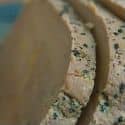 The liver of any animal is packed with vitamins and minerals, and is best prepared steamed or fried with onions and herbs. Veal liver provides the most copper with 15mg per 100g serving or 81% of the RDA. A typical 67 gram portion will provide 504% of the RDA for copper. A single tablespoon of pâté will provide 0.5mg of copper or 3% of the RDA.
The liver of any animal is packed with vitamins and minerals, and is best prepared steamed or fried with onions and herbs. Veal liver provides the most copper with 15mg per 100g serving or 81% of the RDA. A typical 67 gram portion will provide 504% of the RDA for copper. A single tablespoon of pâté will provide 0.5mg of copper or 3% of the RDA.  Depending on type and variety oysters provide 1-8mg of copper per 100g serving, accounting for 37%-500% of the RDA. The oyster highest in copper is the steamed wild eastern oyster which provides 0.5mg(27% RDA) per oyster. In general, wild caught oysters provide more copper than farm raised.
Depending on type and variety oysters provide 1-8mg of copper per 100g serving, accounting for 37%-500% of the RDA. The oyster highest in copper is the steamed wild eastern oyster which provides 0.5mg(27% RDA) per oyster. In general, wild caught oysters provide more copper than farm raised. Dried sesame seeds make a great topping and contain 7.75mg of copper per 100 gram serving or 204% of the RDA, that is 0.4mg (18%RDA) per table spoon. Tahini is commonly found in hummus, a ground chickpea spread and dip of the middle east, it will provide 0.24mg (12% RDA) of copper per tablespoon.
Dried sesame seeds make a great topping and contain 7.75mg of copper per 100 gram serving or 204% of the RDA, that is 0.4mg (18%RDA) per table spoon. Tahini is commonly found in hummus, a ground chickpea spread and dip of the middle east, it will provide 0.24mg (12% RDA) of copper per tablespoon.  Unsweetened cocoa powder is a versatile ingredient that can be used in hot chocolate or chocolate banana pudding. 100 grams will provide 3.8mg of copper or 189% RDA. That is 3.3mg (163% RDA) of copper per cup, and 0.18mg (9% RDA) per tablespoon. A square of baking chocolate will provide 0.9mg of copper (47% RDA).
Unsweetened cocoa powder is a versatile ingredient that can be used in hot chocolate or chocolate banana pudding. 100 grams will provide 3.8mg of copper or 189% RDA. That is 3.3mg (163% RDA) of copper per cup, and 0.18mg (9% RDA) per tablespoon. A square of baking chocolate will provide 0.9mg of copper (47% RDA). 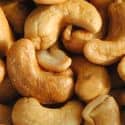 Nuts make a great snack, and are also a good source of copper. Cashew nuts provide the most copper with 2.2mg (111% RDA) per 100 gram serving, that is 3mg (152% RDA) per cup, and 0.2mg (10% RDA) per tablespoon. Other nuts high in copper include Hazelnuts (88% RDA), Brazil nuts (87% RDA), Walnuts (79% RDA), Pistachios (66% RDA), Pine Nuts (66% RDA), Peanuts (65% RDA), Pecans (60% RDA), and Almonds (59% RDA). Most mixed nuts combos contain 83% RDA per 100 gram serving (3/4 cup).
Nuts make a great snack, and are also a good source of copper. Cashew nuts provide the most copper with 2.2mg (111% RDA) per 100 gram serving, that is 3mg (152% RDA) per cup, and 0.2mg (10% RDA) per tablespoon. Other nuts high in copper include Hazelnuts (88% RDA), Brazil nuts (87% RDA), Walnuts (79% RDA), Pistachios (66% RDA), Pine Nuts (66% RDA), Peanuts (65% RDA), Pecans (60% RDA), and Almonds (59% RDA). Most mixed nuts combos contain 83% RDA per 100 gram serving (3/4 cup).  Calamari (or squid) and lobster are both high in copper. 100 grams of calamari will provide 2.1mg of copper for 106% of the RDA. 100 grams of lobster will provide 1.9mg of copper or 97% RDA. That is about 2.8mg (140% RDA) per cup of lobster meat.
Calamari (or squid) and lobster are both high in copper. 100 grams of calamari will provide 2.1mg of copper for 106% of the RDA. 100 grams of lobster will provide 1.9mg of copper or 97% RDA. That is about 2.8mg (140% RDA) per cup of lobster meat.  A great snack on the go, or a great garnish on salads and soups, sunflower seeds provide 1.8mg (92% RDA) of copper per 100 gram serving. That is 2.5mg (123% RDA) per cup and 0.5mg (26% RDA) per ounce.
A great snack on the go, or a great garnish on salads and soups, sunflower seeds provide 1.8mg (92% RDA) of copper per 100 gram serving. That is 2.5mg (123% RDA) per cup and 0.5mg (26% RDA) per ounce.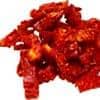 Sun Dried Tomatoes are delicious in a sandwich or as an ingredient in pasta sauce. 100 grams (about 2 cups) will provide 1.4mg of copper or 71% of the RDA. That is 0.8mg (38% RDA) per cup, and 0.03mg(1% RDA) per piece.
Sun Dried Tomatoes are delicious in a sandwich or as an ingredient in pasta sauce. 100 grams (about 2 cups) will provide 1.4mg of copper or 71% of the RDA. That is 0.8mg (38% RDA) per cup, and 0.03mg(1% RDA) per piece. 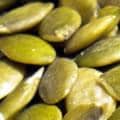 Roasted Pumpkin and Squash Seeds
Roasted Pumpkin and Squash Seeds 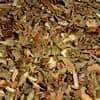 Long used for medicinal purposes, herbs are packed with nutrients and copper is no exception. Dried Basil provides the most copper with 1.4mg per 100 gram serving, or 68% of the RDA. That is 0.03mg (1% RDA) per tablespoon. Other herbs high in copper include Marjoram (57% RDA), Oregano (47% RDA), Thyme (43% RDA), Savory (42% RDA), and Parsley (32% RDA).
Long used for medicinal purposes, herbs are packed with nutrients and copper is no exception. Dried Basil provides the most copper with 1.4mg per 100 gram serving, or 68% of the RDA. That is 0.03mg (1% RDA) per tablespoon. Other herbs high in copper include Marjoram (57% RDA), Oregano (47% RDA), Thyme (43% RDA), Savory (42% RDA), and Parsley (32% RDA).